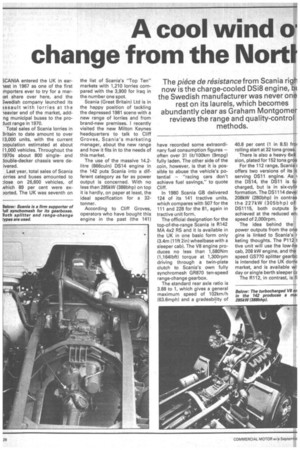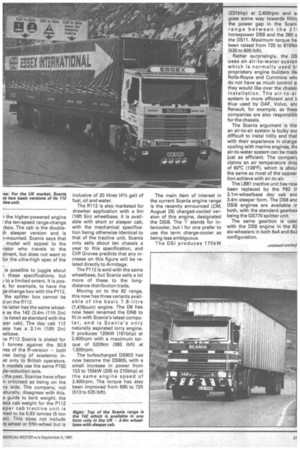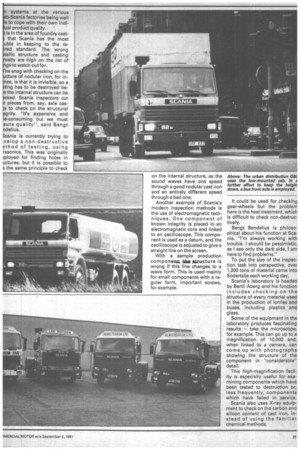A cool wind o change from the Nord
Page 18

Page 19

Page 20

Page 21

If you've noticed an error in this article please click here to report it so we can fix it.
The piece de resistance from Scania righ now is the charge-cooled DSi8 engine, bt the Swedish manufacturer was never one rest on its laurels, which becomes abundantly clear as Graham Montgomer reviews the range and quality-control methods.
;CANA entered the UK in earlest in 1967 as one of the first mporters ever to try for a mar(et share over here, and the iwedish company launched its assault with lorries at the -wavier end of the market, addng municipal buses to the proluct range in 1970.
Total sales of Scania lorries in 3ritain to date amount to over 13,000 units, with the current population estimated at about 11,000 vehicles. Throughout the 1970s about 800 singleand Jouble-decker chassis were deivered.
Last year, total sales of Scania orries and buses amounted to ;lose on 26,600 vehicles, of ovhich 89 per cent were exported. The UK was seventh on the list of Scania's "Top Ten" markets with 1,210 lorries compared with the 3,900 for Iraq in the number one spot.
Scania (Great Britain) Ltd is in the happy position of tackling the depressed 1981 scene with a new range of lorries and from brand-new premises. I recently visited the new Milton Keynes headquarters to talk to Cliff Groves, Scania's marketing manager, about the new range and how it fits in to the needs of this market.
The use of the massive 14.2litre (866cuin) DS14 engine in the 142 puts Scania into a different category as far as power output is concerned. With no less than 285kW (388bhp) on top it is hardly, on paper at least, the ideal specification for a 32tonner.
According to Cliff Groves, operators who have bought this engine in the past (the 141) have recorded some extraordinary fuel consumption figures — often over 31 lit/100km (9mpg) fully laden. The other side of the coin, however, is that it is possible to abuse the vehicle's potential — "racing cars don't achieve fuel savings," to quote Cliff.
In 1980 Scania GB delivered 124 of its 141 tractive units, which compares with 507 for the 111 and 228 for the 81, again in tractive unit form.
The official designation for the top-of-the-range Scania is R142 MA 4x2 RS and it is available in the UK in one basic form only (3.4m (lift 2in) wheelbase with a sleeper cab). The V8 engine produces no less than 1,580Nm (1,164Ibft) torque at 1,300rpm driving through a twin-plate clutch to Scania's own fully synchromesh GR870 ten-speed range-change gearbox.
The standard rear axle ratio is 3.88 to 1, which gives a general maximum speed of 102km/h (63.6mph) and a gradeability of 40.8 per cent (1 in 8.5) froi rolling start at 32 tons gross.
There is also a heavy 6x4 sion, plated for 152 tons gros For the 112 range, Scania offers two versions of its lc serving DS11 engine. As 1 the DS14, the DS11 is tu charged, but is in six-cylir formation. The DS1114 devel 208kW (280bhp) in contras the 227kW (3 0 5bhp) of DS1115, both outputs bi achieved at the reduced ent speed of 2,000rpm.
The idea behind the power outputs from the one gine is linked to Scania's r keting thoughts. The P112 1 tive unit will use the low-he cab, 208 kW engine, and the speed GS770 splitter gearbo is intended for the UK domE market, and is available wi day or single berth sleeper cz The R112, in contrast, is fi
-1 the higher-powered engine I the ten-speed range-change rbox. The cab is the doubleth sleeper version and is -1-mounted. Scania says that
model will appeal to the rator who travels to the itinent, but does not want to for the ultra-high spec of the is possible to juggle about these specifications, but / to a limited extent, It is pose, for example, to have the 3e-change box with the P112, the splitter box cannot be d on the R112.
Ile latter has the same wheel e as the 142 (3.4m (lift 2in) : is listed as standard with the per cab). The day cab 112 ssis has a 3.1m (10ft 2in) elbase.
le P112 Scania is plated for 3 tonnes against the 50.9 nes of the A-version both ires being of academic in!st only to British operators. h models use the same P750 ;le-reduction axle.
the past, Scanias have often n criticised as being on the vy side. The company, not aturally, disagrees with this. a guide to kerb weight, the ssis cab weight for the P112 eper cab tractive unit is -ned to be 5.93 tonnes 15 ton ivt). This does not include re wheel or fifth-wheel but is
inclusive of 20 litres (41/2 gal) of fuel, oil and water.
The R112 is also marketed for drawbar application with a 5m (16ft 5in) wheelbase. It is available with short or sleeper cab, with the mechanical specification being otherwise identical to that of the tractive unit. Scania only sells about ten chassis a year to this specification, and Cliff Groves predicts that any increase on this figure will be related directly to Armitage.
The P112 is sold with the same wheelbase, but Scania sells a lot more of these to the longdistance distribution trade.
Moving on to the 82 range, this now has three variants available of the basic 7.8-litre (7,476cuin) engine. The D8 has now been renamed the DN8 to fit in with Scania's latest compute r, and is Scania's only naturally aspirated lorry engine. It produces 120kW (161bhp) at 2,400rpm with a maximum torque of 520Nm (380 Ibft) at 1,50Orpm.
The turbocharged DS803 has now become the DS805, with a small increase in power from 153 to 155kW (205 to 210bhp) at the same engine speed of 2,400rpm. The torque has also been improved from 695 to 725 (513 to 535 lbft).
The main item of interest in the current Scania engine range is the recently announced (CM, August 29) charged-cooled version of this engine, designated the DSi8. The 'V stands for intercooler, but I for one prefer to use the term charge-cooler as being less ambiguous,
The DSi produces 170kW (231bhp) at 2,400rpm and si goes some way towards fillini the power gap in the Scani, range between the 211 horsepower D58 and the 280 o the DS11. Maximum torque ha been raised from 725 to 815Nn (535 to 600Ibft).
Rather surprisingly, the DS uses an air-to-water systen which is normally used b■ proprietary engine builders liki Rolls-Royce and Cummins wh( do not have as much control a: they would like over the chassii installation. The air-to-ai system is more efficient and thus used by DAF, Volvo, an Renault, for example, as thes( companies are also responsiblE for the chassis.
The Scania argument is tha an air-to-air system is bulky anc difficult to instal tidily and that with their experience in charge cooling with marine engines, thE air-to-water system can be madE just as efficient. The compam, claims an air temperature drop of 60°C (108°F), which is aboui the same as most of the opposi. tion achieve with air-to-air.
The LB81 tractive unit has no been replaced by the P82 ir 3.1m-wheelbase day cab anc 3.4m sleeper form. The DS8 anc DSi8 engines are available ir both, with the standard gearbox being the GS770 splitter unit. The same gearbox is used with the 0S8 engine in the 82 six-wheelers in both 6x4 and 6x2 configuration.
With the 16-ton two-axle chass, the standard gearbox is the ye-speed G770, which is the lentical gearbox without the No-speed planetary splitter nit. As I mentioned earlier, the aturally aspirated version of le 7.8-litre unit can be specified )rthe 82 as an alternative to the
58.
Scania offers an Allison autolatic gearbox as an option for le 82, but this is only with the Jrbocharged engine.
The P82M 16-ton rigid is ffered with five wheelbase opons ranging from the 3.8m I2ft6in) tipper chassis to a 5.8m I9ft) model. Scania has found let the 5.4 and 5.8m versions ave proved the most popular, s the former is ideal for a (pical UK 24ft body while the .8m chassis can take a 26ft ody or a 24ft one and a sleeper ab.
This year, Scania has added ie G82M to its range, which is rnly available in rigid form. It is lechanically identical to the P82 iut has been modified to local lelivery specification by having
lower frame and a lower nounted cab. Low profile 95/70R 22.5 tyres are fitted and, gain to keep the height down, a ius front axle is also fitted.
With any manufacturer, the luality of its product is all-imiortant and it is in this area that ;culla employs some interest ing variations on the basic theme of inspection and quality control.
According to quality manager, Bengt Bendelius, his department is a mixture of the old-fashioned "inspection" function and a modern quality control department. At Scania the routine inspection work is left to the production side and merely guided by the QC department.
In practice, this means that if production finds something outside limits, they must ask the inspection side has no power of decision.
Sodertalje, the home of Scania, is the official "measuring centre" for the whole of the Saab-Scania organisation and the equipment being used reflects this status. For example, an advanced measuring machine from Germany is now installed which can literally check all the dimensions of a cylinder block automatically overnight and leave the printed results for analysis the following morning.
As a matter of interest, a lot of Scania's inspection techniques have been inherited from other advanced technology areasnuclear, for instance.
Saab-Scania, of course, produces more than just heavy lorries petrol engines for Saab cars being just one example of the overall product range from Sodertalje. So, Bengt Bendelius is responsible for both the petrol and the diesel side, both of which have their own different disciplines. On engine test, for example, the petrol engines are merely started and run for a few minutes to "see if they work". The diesel engine, however, is tested more carefully, with particular reference to power output and fuel consumption, by being put through a 90-minute test. The results of this are kept on file, and are readily available in the case of any warranty problems.
The same system is applied in principle at least to gearboxes and axles. The gearbox, for example, is run on a test bench against a dynamometer and put through the complete gearchange cycle. Apart from this bench test, the box also gets checked over after installation in the vehicle.
Each Scania is road-tested as well as being put on a roller brake, though the latter is used in this instance to check for fluid leaks. This is a comparatively short road test but, in addition to this, random samples are taken from the line and put through a longer test.
Scania has its own short test track within the factory at Sodertalje, so the drivers can carry out repeatable tests without the aggravation of traffic. Road rollers can also be used as required which eliminate weather problems.
There are two vehicle inspection systems used by Scania; one is an ordinary inspection carried out at the factory which is followed by the pdi carried out through the distributors. For direct delivery vehicles which do not go through a distributor (for example, those intended for the military), Scania carries o combined factory and the delivery inspection.
The company does not r an incoming inspection of thing which is produce( another Saab-Scania factor one more aspect of the pany's philosophy which prised me when I visited Sc talje recently. Ot manufacturers carry out same inspection procec whether the component is duced "inhouse" or frorr outside supplier.
According to Bengt BendE the Scania system has pn very satisfactory with the in n systems at the various b-Scania factories being well e to cope with their own indi ual product quality.
is in the area of foundry castthat Scania has the most uble in keeping to the reired standard. The wrong tallic structure and casting osity are high on the list of gs to watch out for, he snag with checking on the cture of nodular iron, for inrice, is that it is invisible, so a ting has to be destroyed bee the internal structure can be cked. Scania inspectors cut t pieces from, say, axle cass to check on the structural pgrity. "It's expensive and le-consuming but we must sure quality", said Bengt ndelius.
3cania is currently trying to velop a non-destructive ethod of testing, using rasonics. This was originally Iployed for finding holes in uctures, but it is possible to a the same principle to check on the internal structure, as the sound waves have one speed through a good nodular cast iron and an entirely different speed through a bad one.
Another example of Scania's modern inspection methods is the use of electromagnetic techniques. One component of known integrity is placed in an electromagnetic core and linked to an oscilloscope. This component is used as a datum, and the oscilloscope is adjusted to give a straight line on the screen.
With a sample production
component I lructure is wrong if this line changes to a wave form. This is used mainly for small components with a regular form, important screws, for example.
It could be used for checking gear-wheels but the problem here is the heat treatment, which is difficult to check non-destructively.
Bengt Bendelius is philosophical about his function at Scania. "I'm always working with trouble. I should be pessimistic, as I see only the dark side. I am here to find problems."
To put the size of the inspection task into perspective, over 1,200 tons of material came into Sodertalje each working day.
Scania's laboratory is headed by Bertil Aberg and his function includes checking on the structure of every material used in the production of lorries and buses, including plastics and glass.
Some of the equipment in the laboratory produces fascinating results — take the microscope, for example. This can go up to a magnification of 10,000 and, when linked to a camera, can come up with photographs showing the structure of the component in "considerable" detail.
This high-magnification facility is especially useful for examining components which have been tested to destruction or, less frequently, components which have failed in service.
Scania also uses X-ray equipment to check on the carbon and silicon content of cast iron, instead of using the familiar chemical methods.








































